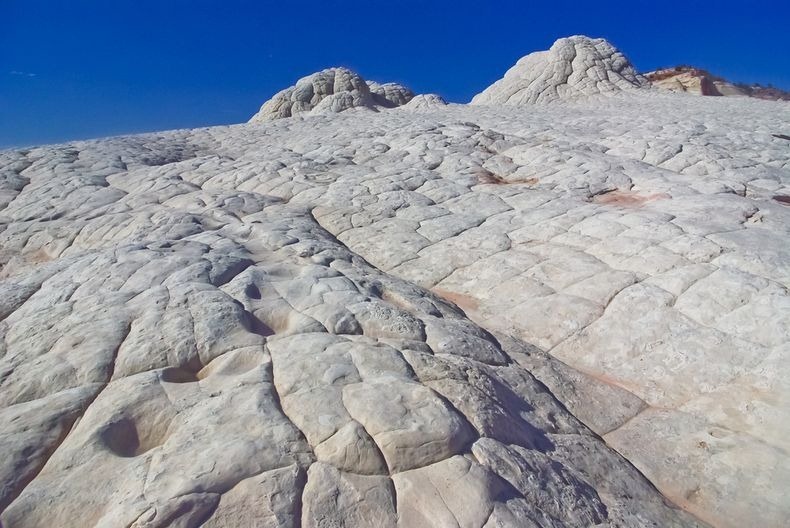White Pocket, Vermilion Cliffs National Monument, Arizona
The White Pocket is an isolated, notoriously hard-to-reach patch of sandstone hidden within the desert expanse of Vermillion Cliffs National Monument near the Arizona/Utah border. The entire area is covered in a gray rocky layer, sometimes only a few centimeters thick, above the red sandstone where the formations heave and drip that makes the entire landscape look like as if it was covered with icing sugar. In some spots the stone layers are completely twisted, just like an enormous marble cake. The extraordinary geology at White Pocket is not easily explained. Some geologist proclaim that White Pocket is a result of “soft sediment deformation”, meaning the contortions and twisting and turning at White Pocket occurred back in Jurassic time while the sand was saturated and before the sand was completely turned into rock.

Photo credit: unknown
According to one retired petroleum geologist Marc Deshowitz, who studied White Pocket more than anyone else, believes the landscape was the result of a huge sand-slide mass, triggered by an earthquake, detaching from a tall dune and traveling rapidly downslope. As the mass slid and tumbled downslope, it ripped up chunks of laminated sand beneath that intermixed with the basal part of the slide. The sand mass eventually filled a large pond or oasis. This large sand mass is the featureless bleached-white sandstone or "cauliflower rock" seen today. The instantaneous loading from the sand mass caused pressure adjustments within the underlying saturated sand resulting in contortions and fluid escape structures such as sand volcanoes. Marc has identified at least 25 of these features supporting his theory.
The fine laminae and cross-beds beneath the slide mass are remarkably well-preserved. This may indicate all of the sand involved was buried under a fairly thick column of additional sediment. In other words, the slide plane may have been several 100 feet below the surface. This overburden pressure would have allowed the plastic-like contortions but still keep things somewhat in order.
Only a year ago, White Pocket was relatively obscure, formerly known only by local ranchers and a handful of adventurous photographers. Then National Geographic ran a story on the Vermilion Cliffs National Monument, which included some excellent photos of White Pocket. Since the magazine’s release there has been a surge of activity at White Pocket. Today, White Pocket is in the bucket list of every hiker and outdoor enthusiast.

Photo credit

Photo credit

Photo credit

Photo credit

Photo credit

Photo credit

Photo credit

Photo credit

Photo credit

Photo credit

Photo credit

Photo credit

Photo credit

Photo credit

Photo credit: unknown
According to one retired petroleum geologist Marc Deshowitz, who studied White Pocket more than anyone else, believes the landscape was the result of a huge sand-slide mass, triggered by an earthquake, detaching from a tall dune and traveling rapidly downslope. As the mass slid and tumbled downslope, it ripped up chunks of laminated sand beneath that intermixed with the basal part of the slide. The sand mass eventually filled a large pond or oasis. This large sand mass is the featureless bleached-white sandstone or "cauliflower rock" seen today. The instantaneous loading from the sand mass caused pressure adjustments within the underlying saturated sand resulting in contortions and fluid escape structures such as sand volcanoes. Marc has identified at least 25 of these features supporting his theory.
The fine laminae and cross-beds beneath the slide mass are remarkably well-preserved. This may indicate all of the sand involved was buried under a fairly thick column of additional sediment. In other words, the slide plane may have been several 100 feet below the surface. This overburden pressure would have allowed the plastic-like contortions but still keep things somewhat in order.
Only a year ago, White Pocket was relatively obscure, formerly known only by local ranchers and a handful of adventurous photographers. Then National Geographic ran a story on the Vermilion Cliffs National Monument, which included some excellent photos of White Pocket. Since the magazine’s release there has been a surge of activity at White Pocket. Today, White Pocket is in the bucket list of every hiker and outdoor enthusiast.

Photo credit

Photo credit

Photo credit

Photo credit

Photo credit

Photo credit

Photo credit

Photo credit

Photo credit

Photo credit

Photo credit

Photo credit

Photo credit

Photo credit